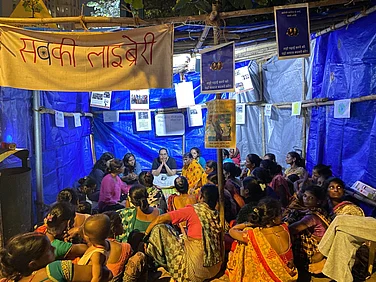Naina can do anything. The world is her oyster, and her Instagram page—with more than 320,000 followers—a fount of possibilities. Aspiring to break into Bollywood, she is already a star—an influencer. Three months ago, she met with Manoj Bajpai to promote his 100th film, Bhaiyya Ji. She asked him to translate some Gen Z slangs in Bhojpuri, such as “I slayed at the party last night.” He replied, “Phadiye diye hum party mein.” And just like that, in less than a minute, Naina made a boring event fun.
She launched a podcast, The Naina Show, where she interviewed Sobhita Dhulipala, Richa Chadha, and Kritika Kamra. She can dance, ace the airport look, floor the paps. She can teach you how to drape a saree, braid your hair, pose at a wedding. She has many avatars, many forms, turning life itself into a series of auditions. She’s a feminist and a perfect girlfriend. “Accha, go ahead, buy your favourite bike, we can go on a holiday next year as well,” she says in the video ‘the girlfriend we all need’. Cut to: “You want coffee? Let me make it for you.” Then: “It’s okay, go ahead, you deserve a boys’ night.”
So, yes, Naina can do (almost) anything—except being real. Yeah, for real, because she’s an AI avatar. Not that her audiences seem to mind. A typical post by her receives thousands of comments, similar to many real female influencers: some admiration here (“my crush”), some testosterone there (“sexy girl”). Many sound puzzled—“Day 34 of asking, yeh real hai ya fake”; “bhai, yeh girl hai ya robot?”—and yet the admiration continues. It makes sense: Beauty, after all, lies in the AI of the beholder.
She’s not the only one. There’s Kyra (262K followers), MAYA (170K followers), Virat_Avtr (97K followers), Roshni__AI (45K followers), Zara Shatavari (20K followers), and several more. They often collaborate with brands. Naina has endorsed many, from Nykaa to Puma to Pepsi. Kyra: L’Oréal, Realme, American Tourister. MAYA is owned by a brand itself, Myntra. This trend has exploded worldwide: The most popular AI influencer, Lu do Magalu, from Brazil, has over 7 million followers. Miquela, based in LA, has around 2.5 million followers; the iconic character Barbie, 3.5 million. In July 2024, the Moroccan influencer Kenza Layli won the world’s first Miss AI pageant among 1,500 contenders. India’s Zara was a top 10 finalist.
The influencer culture, a Gen Z phenomenon, defied the tyranny of corporate jobs. If you had a unique and compelling voice, then you could build a sizable following. That’s when the brands entered, partnering with influencers to promote products. But in the corporate world, where everything must be done yesterday, human influencers can only do so much. Their AI counterparts, though, can work 24 hours a day, consume voluminous data, and attract no controversy. They also don’t age, come for cheap, and serve humans—without peep or protest.
Something else unites the female AI avatars: most of them look the same—slim, fair, meek. They’re also designed by men. “My AI avatar is cheaper, more flexible, and doesn’t talk back,” Mohammad Saray, part of a team that designed the Miss AI finalist from Turkey, told NPR. In the analog world, men controlled women’s choices; in the AI world, they control women’s beings. Devoid of real-life imperfections, the female AI influencers exacerbate stereotypical definitions of beauty, looking like docile dolls who crowd out the fighting, bleeding women.
Some virtual influencers do show diversity though. Shudu Gram for instance, a rare black model, has over 240,000 followers. But it was also criticised because it was created by a white man. “Pressured by young people, many companies are creating ethnically diverse characters,” says Karthik Kalyanaraman, an art critic and academic. “But who is the one making money from them—is he ethnically diverse?”
For a long time, varied artistic expressions—reflecting creativity and providing fun—made us unique, real, and human. But AI has breached that sanctum, too. Now fun itself can be coded and paraded via servile bots. “Social media was sold to us [on the principle that], ‘Look, you can be a creator. Look, your creativity can make you money,’” says Kalyanaraman. “But AI influencers have given it an ironic twist.” Now the person with the resources and the money to create a sophisticated AI influencer will have more... influence, he adds, it’s not so much about creativity anymore. Not long ago, a “gaon ka ladka”, he says, could become an influencer and earn money from brands. “What about AI influencers then? They don’t need a gaon ka ladka anymore. They can create their own gaon ka ladka.”
What does the future look like, then, for (real-life) influencers? Will they start cloning—or ‘AI-ing’—themselves to keep up? Will that be the final step in our complete ‘machinfication’: Machines defeating humans who will be compelled to become machine-like to, well, defeat machines? That, in fact, has already begun. In January 2024, Sunny Leone unveiled her AI clone. Trained on her voice and personal data, it can interact with users through chats or calls, simulating the real actor. It came eight months after Mouni Roy and her husband, Suraj Nambiar, presented the AI influencer Tia Sharma. The trend of AI influencers, says Kalyanaraman, is only going to increase. “But [ultimately] we’re also hardwired to connect to people.” The novelty will fade away at some point, he adds, then people will get tired of it. “Or at least,” he says, laughing, “that’s the hope.”


























